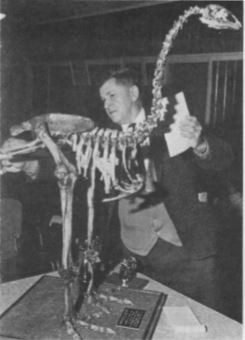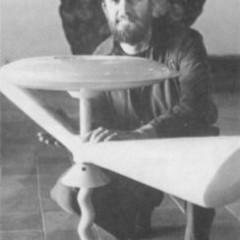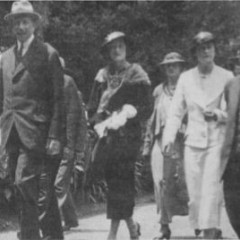10:4
The City Express was started in 1963 by three New Plymouth journalists, Vic Crane, Jim Thompson and Ray O'Connor, as an advertising sheet distributed free with the morning milk. In 1968, with its named changed to Sunday Express, it was taken over by Taranaki Newspapers and by 1980 its circulation was 14,000 'delivered to every household'. Editor was Murray Moorhead.'?
'This is Station 2YB, New Plymouth, operated by the North Taranaki Radio Society and broadcasting from Collier's Music House, Devon Street, New Plymouth.' This announcement, spoken by John Ball, on Saturday evening, April 27, 1929, brought 'the wireless' to New Plymouth. (Eight years previously Professor Robert Jack had broadcast 'vocal and musical items' on a trial basis from the Department of Physics, Otago University. His experiment was a success and the newly formed Broadcasting Company of New Zealand opened stations in Auckland, Wellington, Christchurch and Dunedin.) But reception in New Plymouth, separated from Auckland and Wellington by mountain barriers, was marginal, even for the most sophisticated 'all-electric and battery receivers with seven valves and genuine moving coil loudspeakers' as advertised by J. B. MacEwan in 1929, 'for only £48 ($96)'. The North Taranaki Radio Society, formed in 1928, had spent many months trying unsuccessfully to have reception improved and it approached the Broadcasting Company for the loan of equipment and experts to operate it so that listeners could at least get some satisfaction from their Post Office licence fee of$3. This was forthcoming, and with additional income from members of the radio society and publicly subscribed funds, the first station went on air with a gala performance of items by Taranaki artists, interspersed with 'official speeches' limited to five minutes each. The Hawera Savage Club Orchestra provided 'overture selections' and other artists included L. Bosworth and R. George, the Melody Four (comprising F. A. Hooker, W. P. Okey, B. Bellringer and A. B. Macdonald, who rendered Gone are the Days), George Blake, Evelyn Dowling, Harold Morley and Jack Quinn. The man behind the effort to provide the service was Edward Payne, president of the radio society and first station director. The event was a success. 'According to experts', said the Taranaki Herald, 'the studio (on the fourth floor of Colliers) compares more than favourably with any in New Zealand.' The plant and equipment was valued at $1500, heavy carpets were used to deaden outside noise, a heavy curtain was placed across the Devon Street windows, and the aerial stretched from the 'roof of Colliers to the top of Messrs Sole's buildings' . For the next 33 years the society continued to entertain listeners,
whose receivers graduated from home-made catswhisker crystal sets to the latest in battery and electric Zenith Fada, Majestic, Atwater ('it speaks for itself) and HMV receivers. For two nights weekly, in the beginning, from 6 p.m. to 10 p.m., broadcasts included children's sessions, market reports, sporting and general items (later to become the News), and concert sessions, with 'live' broadcasts of some of the more important sporting events. For transmitting gramophone records' an instrument was used known as a magnetic pick-up. This converts the needle vibrations into electrical impulses which are fed into the speech amplifier. By this means the characteristic tone of the gramphone is entirely eliminated and in a great number of cases it is impossible to distinguish between a record item and the original rendering.' 13 Early in 1932 the station moved into the Empire Building in King Street, where it remained for more than 20 years as a 'purely amateur undertaking' although the Broadcasting Company (in that year it became the New Zealand Broadcasting Board) trained a professional technician to service its equipment. Under the Broadcasting Act of 1936 New Zealand's first Labour Government abolished the broadcasting board, all of whose rights, property, liability and engagements were transferred to the Crown. The broadcasting portfolio was assumed by Prime Minister Savage, and the first director of the National Broadcasting Service was Professor James Shelley. Among the provisions of the Act was one providing for programmes of all privately-operated stations to be subject to ministerial scrutiny. Advertising was absolutely prohibited, except from commercial stations controlled by the Minister. These conditions at first meant little to New Plymouth, whose station was still run by the radio society, although there was increasing NBS equipment installed. In 1948 2YB became 2XP, and in September 1952 the station was moved into the top floor of the warehouse of Mackay, Logan, Caldwell Ltd on the corner of Brougham and Powderham Streets. Extended transmission times were announced 'which will provide additional programme services to listeners and at the same time enable the station to meet further the advertising requirements of the business community,' said the Taranaki Herald. This spelt the end of the radio society's control, and at a ceremony to mark the opening of the new service, Ted Payne, who was still president of the society, told the bevy of government, civic and business officials: 'I firmly believe that this is predominantly a homely type of district which prefers a non-commercial type of station.' While the society had sought to have the local service improved it had not asked for a commercial station. 'However, in your wisdom Mr Minister (R. M. Algie) and Mr Director (W. Yates) you have elected to give us the composite-type station. It will not completely satisfy Taranaki.'
He was right. While advertising and the more popular type of music and other programmes apparently appealed to many listeners, for those who preferred the more serious National and Concert programmes reception was marginal. Over the intervening years this has improved, but it was still a subject of great controversy in 1980, and, according to experts, would not improve until the internationally-used FM transmission system replaced the AM method. And none could predict when, or if, this would occur. Thus, the opening of the Brougham Street studios, with Tahu Shankland as its manager, marked the end of23 years of broadcasting by an amateur station. During this time hundreds of local artists had appeared before the microphone, and always the figure in the background had been Ted Payne (Uncle Ted to the children) assisted, among others, by Bert Lee. The next move of Radio Taranaki came in 1966 with the opening by Minister of Broadcasting (for the New Zealand Broadcasting Corporation) W. J. Scott, of a new $300,000 building across the road in upper Brougham Street. The building of this station was dogged by two years of administrative and construction delays. This historic site had been occupied by a Maori pa, a military camphouse, a doctor's residence, a boot-maker's factory, and a private residence. When old buildings were pulled down, newspapers dating back to the 1850s were found, 'along with the skeleton of a very tall man' , according to the Taranaki Herald. Extended hours of broadcasting were instituted for this community station, the main transmitting aerial for which was erected at Bell Block. The station was designed by Hawera architect David Robinson and the focal point on the front of the building was a large mosaic mural created by A. N. Banks of Lower Hutt. With its opening 2XP ceased to exist as one station, when its coverage was extended to include 2ZH at Hawera through a new transmitter. At that time Radio Taranaki was reaching a population of almost 74,000. Of the original staff of the Brougham Street studios, three members moved into the new building-Bob Forsyth, Peter Lankshear and Cliff Walker. Voices which became well-known to New Plymouth listeners, in addition to Payne's, have included those of Joan Foster, Tony Smale, Herbert Mullon, Betty Aylward, Margaret Edwards, George Corney, Jack Quinn, Murray Hewson, Brian Clark, Mark Comber (38 years as a sports commentator-'the man who knows the score'), Marama Koea (formerly a teacher and later Marama Martin, a television personality, Eugene Fraser, Margaret Moore and Betty Turnbull. New Plymouth's problems associated with obtaining radio coverage were duplicated in efforts regarding television. In May, 1952, Canter- bury University College, through its experimental station, gave the first television broadcast in the country, which was received up to two kilometres from the transmitting point.!"
Experiments continued and by 1958 the Bell Radio and Television Corporation, Auckland, was telecasting three nights a week to an estimated 100 set-holders. Two years later the Government decided to introduce television as an entertainment medium. Within two years each of the four main centres had its own station-none of which was received in New Plymouth. Auckland, the nearest line-of-sight station, was the one to concentrate on and, with a view to obtaining this latest entertainment service (although enthusiasts, with the help of very tall aerials, could bring in the signal occasionally), the North Taranaki Translator Society was formed with a view to making it available for all who could afford it. Apublic meeting was called on 9 May, 1963, sponsored by the New Plymouth Chamber of Commerce, at which Colin Marceau presided . over more than 200 people. Bill Dean (president), Peter Ferens, Dick Smith and Doug Horton (secretary) were appointed as the operating committee; ajoining fee of$1 0 was set, and television retailers promised $50 each if the project was feasible. It was. Equipment costing $1736 was purchased ($1000 of which was subscribed by the retailers). Permission was obtained, with some difficulty, from the Egmont National Park Board to erect the translator on Mt Egmont near the North Egmont Chalet, and following a deputation to the Director General of Broadcasting, Gilbert Stringer, the Post Office was reluctantly persuaded to issue the necessary transmit- ting licence .15 In June, 1963, about 250 subscribers-and a lot of non-subscribers-were able to watch programmes in black and white, like 'Peyton Place' and 'Coronation Street'. For three years the society provided service to the growing number of subscribers, with its translator beamed on to AKTV2 via a 100kw transmitter on Mt Te Aroha in Waikato. But it was expensive-not only in money, but in time and frustration for the team of enthusiasts led by Dick Smith: high winds on Egmont devastated aerials, there was icing up in the winter which distorted and often destroyed the signal, there was no electric power which necessitated the purchase and servicing of a diesel-driven generator. Growing agitation from the increasing users of television resulted in the NZBC agreeing to install a more sophisticated translator on the Hen and Chickens site, 1430 metres above sea level. This required construction of a very steep access road, a 40-metre steel transmission tower capable of withstanding winds of up to 240 kph, two prefabricated geodesic domes to house the equipment, and a suitable electricity supply. The repeater station came into operation on December 1, 1966. Operating on Channel 6, the height, position and power gave a much improved coverage to north, east and a few south Taranaki viewers. They were now receiving the Wellington programme instead of Auckland's, though the latter could still be received in elevated areas in poor quality.


